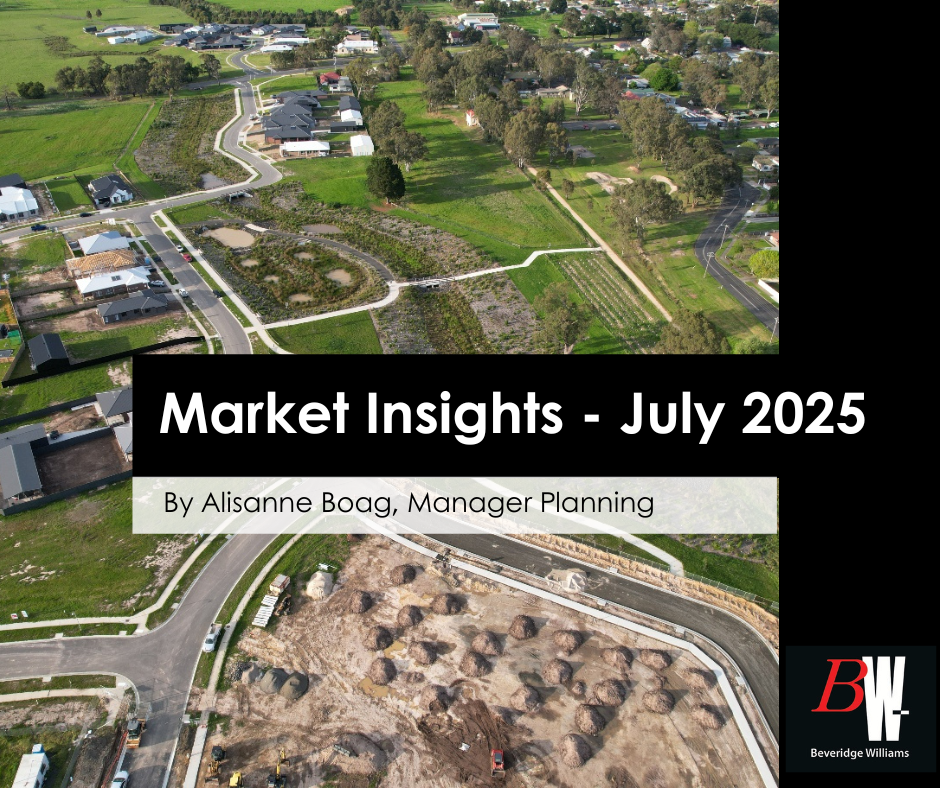Land Development Market Insights – July 2025

Understanding the evolving land development landscape in Victoria and New South Wales
The 2024–25 financial year closed with some welcome signs of renewed interest in the property market, but challenges remain across both Victoria and New South Wales. Recent interest rate cuts earlier in the year helped lift buyer confidence, and new home sales in both states reached their highest levels in over a year during May. In an encouraging sign, strong new home sales carried into June, wrapping up the strongest quarterly sales performance for Melbourne and Geelong since the second quarter of 2022. However, volumes remain well below what’s needed to meet current housing demand. Market conditions continue to be shaped by high construction costs, policy uncertainty, increasing tax burdens, and infrastructure constraints.
Victoria: planning uncertainty and policy pressure
Victoria’s policy environment remains under scrutiny. Recent planning reforms have raised concerns about the feasibility of ambitious housing targets, especially as the State Government seeks to shift growth into established areas. Greenfield land supply is slowing, and planning certainty is being tested — particularly in regional markets where new strategic directions, such as fixed settlement boundaries under the Plan for Victoria, are creating uncertainty. Precinct Structure Plan (PSP) processes also remain slow, complex and costly, with rising developer contributions further impacting project viability.
The 2025–26 State Budget was fiscally conservative, but with nearly 47% of state revenue expected to come from property-related taxes and record debt levels, both public and private investment are under pressure. There are encouraging signs in parts of the state (such as the progress of the Creamery Road PSP in Geelong, and Shepparton East PSP).
New South Wales: system reform and renewed investment
In New South Wales, the 2025–26 State Budget introduces several initiatives aimed at boosting housing delivery, including a $1 billion finance guarantee scheme to unlock apartment developments, a new Works-in-Kind (WIK) framework under the Housing and Productivity Contribution, and permanent land tax concessions for build-to-rent projects. Despite these measures, planning system challenges persist. Greenfield development continues to be constrained by infrastructure delivery, while regional areas such as the Central Coast and Illawarra face uncertainty around contribution frameworks.
Regional dynamics
Recent ABS data shows that Melbourne and Sydney are still experiencing net internal migration losses to regional areas, although at a slower rate than in previous quarters. Melbourne recorded its smallest quarterly outflow to the regions since mid-2023, while regional Victoria saw its lowest population gain in over a year. Sydney saw a net outflow of more than 4,000 residents to regional NSW – the second-largest shift since early 2022. These dynamics reinforce the need for clear planning frameworks and infrastructure investment in regional centres, where demand continues to grow.
Industrial market
In both states, industrial land remains in strong demand, particularly in logistics precincts such as Western Sydney and Greater Geelong. However, land shortages, cost escalation and servicing challenges are affecting delivery timelines. The medium and high-density market remains fragile, with feasibility often limited to prime locations where prices can support ongoing construction costs.
What this means for our clients
Our multidisciplinary model, regional footprint, and track record in complex projects continue to set us apart. We’re focused on helping our clients navigate uncertainty with confidence, providing strategic, considered advice that unlocks opportunity and delivers strong project outcomes.
As always, if you’d like to talk to us about your next project, from greenfield and infill developments to infrastructure and advisory services, we’re here to help.